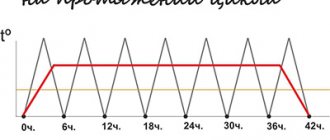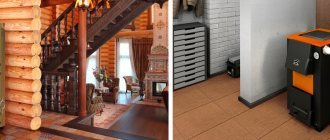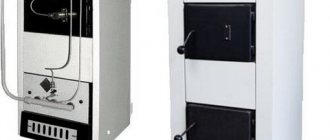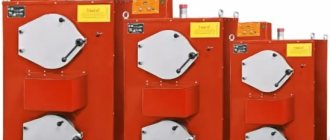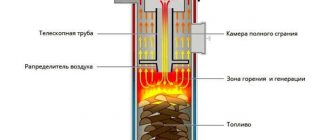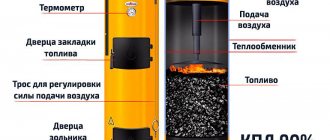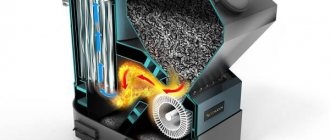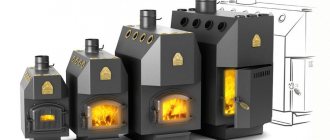Solid fuel boilers have become a part of everyday life in private households. When constructing a new building or replacing outdated equipment, the owner is faced with the question of choosing a boiler installation.
In addition to the criteria of reliability and cost, the time spent plays an important role. For those who do not have the opportunity to refuel and clean out ash several times a day, the Stropuva long-burning solid fuel boiler is suitable.
Features of solid fuel boilers Stropuva
The main difference between Stropuva units is long burning. It is achieved by combining the principle of upper layer-by-layer combustion and the design features of the product.
Device
The boiler design is a shaft of two steel cylinders located one inside the other. The coolant, water, circulates between them.
Inside the smaller cylinder are the combustion chamber and the air heating zone. A heated air flow is supplied from above into the firebox using a telescopic pipe with an air distributor at the end. The air duct rests on the fuel and descends with it as it burns out.
The body is lined with thermal insulation. On its front panel there are two doors: the loading chamber and the ash pan.
Principle of operation
The device implements the combustion principle from top to bottom. It allows fuel to burn more slowly, providing more efficient use of thermal energy. The bookmark is set on fire from above. Only the surface layer of the fuel material burns. As it burns out, the hearth gradually sinks into the lower layers. This ensures uniformity and duration of operation of the unit on one portion of fuel.
More details about the operation of the Stropuva boiler can be seen in this video.
Advantages
Buying such a heating device would be reasonable, because it has many advantages, which we will consider in more detail.
Advantages of Stropuva boilers:
- Economical. The method of layer-by-layer combustion from above, unlike the traditional one, does not create “excess heat” thrown into the chimney. Thermal energy is released evenly and manages to be almost completely transferred to heating the coolant, and not the street. The boiler does not waste fuel resources.
- Energy independence. To operate the heating device in the basic version, no connection to the electrical network is required. It is completely autonomous.
- Safety. The absence of electrical and gas components reduces the risk of accidents. If used incorrectly, the unit may fail and become deformed without causing harm to surrounding objects and people.
- Long combustion cycle. On one stack of firewood, the firebox operates for up to 30 hours. On coal and pellets - even longer. The device will have to be serviced less often than once a day. Ideal for those who value their time.
- Low waste. It is enough to clean the ash chamber a couple of times a month. Thanks to complete combustion, there are practically no combustion residues and resins left.
- Efficiency. Efficiency of 85% is much higher compared to traditional water heating devices.
- Design and dimensions. The device has a modern appearance and does not take up much space in the room.
- Wide palette of 7 body colors. A harmonious solution can be chosen for any interior.
Flaws
It is necessary to keep in mind some of the disadvantages of such boilers.
Disadvantages of Stropuva devices:
- Cyclicality. The boiler goes through the stages of kindling, combustion and end of operation, regardless of the duration of the cycle. Periodically, you have to refill a fresh portion of fuel, remove the ash, and re-ignite the firebox.
- Inconvenient loading window. It is inconvenient to load and distribute firewood through the small door.
- Price. To buy a Stropuva boiler, you will have to spend an amount comparable to the cost of a gas boiler.
- High requirements for fuel quality. It is allowed to burn material with a moisture content of no more than 20%. Otherwise, tar and soot will form on the inner walls.
Reservation of work
The Stropuva boiler will delight you with long-lasting fuel combustion. But even in this case, you can miss the moment of the next bookmark. As a result, the temperature of the coolant in the heating circuit will begin to fall. To prevent this from happening, we recommend installing a backup electric boiler in the circuit. If it detects a temperature drop below the set limit, it will turn on and maintain the set temperature.
Electricity consumption will be small if you don’t forget to add firewood for 2-3 days. The vast majority of the time the boiler will burn, providing heat to consumers. Therefore, you should not expect huge expenses. In addition, the auxiliary boiler does not have to be as powerful as the main one - a model with a power 2-3 times lower is quite enough so as not to make your teeth chatter in the morning. We also recommend working on insulating your home so that it retains the accumulated heat longer.
Types of equipment Stropuva
Stropuva heating devices operate on one or more types of fuel, depending on the model.
Wood-burning
A wood boiler uses hardwood logs, wood and peat briquettes as fuel.
Pellet
The pellet device obtains thermal energy by burning fuel pellets consisting of wood and agricultural waste. It is equipped with an air charge fan, a grate and a specially designed air distributor.
Universal
Universal models, in addition to firewood and pellets, also use coal and anthracite. It is equipped with special parts for working with bulk raw materials.
Review of model range and prices
The range of heating devices in Stropuvo is represented by products of various capacities and configurations. Let's look at the popular models of Stropuva solid fuel boilers and their prices.
Mini S8
Stropuva Mini S8 is a solid fuel single-circuit wood-burning device with a low power of 8 kW. Suitable for heating small rooms from 50 to 80 square meters. m. The installation has modest overall dimensions: height - 1.35 m; diameter - 0.56 m. The firebox can hold up to 37 kg of firewood up to 40 cm long. The maximum operating time on the stack is 18 hours. The dimensions of the loading door are 23x21.5 cm. The model has a basic configuration, including cleaning accessories: a poker and a scoop.
The cost of the model is 53,000 rubles.
Prices for the Stropuva Mini S8 boiler
Stropuva Mini S8
Mini SP8
Unlike the previous model, it is equipped with a grate and an air injection fan. Heating with pellets increases the burning time of one portion to 48 hours.
Price for Stropuva Mini S8P: 56,500 rubles.
Prices for the Stropuva Mini SP8 boiler
Stropuva Mini SP8
S20
Wood-burning version with a power of 20 kW (firewood and briquettes). Capable of heating a room of 100-200 square meters. m. The firebox holds 60 kg of firewood. This is enough to work for 31 hours. The height of the device is 2.1 m. The diameter is standard.
Cost - 85,500 rubles.
S40
The most powerful option is 40 kW. Works on wood. Suitable for residential and industrial buildings with an area of 200 to 400 square meters. m. The loading zone can accommodate up to 93 kg of logs up to 45 cm long. The combustion cycle is up to 31 hours. The design is distinguished by an oversized loading door of 24x23 cm and a diameter of 0.68 m.
The price of Stropuva S40 is 98,600 rubles.
Prices for the Stropuva S40 boiler
Stropuva S40
Other models
The Stropuva model range is represented by versions of 8/15/20/30 and 40 kW with a heating area from 50 to 400 sq. m. m. Basic wood-burning models are marked with the letter “S”. The letter “P” in the name stands for pellet heat generator. Unlike the basic version, it works longer on one tab - up to 72 hours. It is heated with both wood and fuel pellets. The letter “U” denotes universal boilers. Such devices can burn for up to 5 days on coal.
Chimney installation
Good news: you can connect Stropuv boilers yourself if you have experience in similar plumbing work. If you don’t have the skill, go straight to the specialists. Please pay attention to the installation instructions - installation differs from other long-burning solid fuel boilers.
Stropuva
Important! If you install the chimney incorrectly, you expose yourself and the equipment to danger. Violation of requirements leads to the following consequences:
- unstable combustion, lack of traction;
- formation of condensation, less often - the formation of air pockets;
- accumulation of carbon monoxide.
The cases listed are rare, but they have happened in practice before. Today, automation will protect you in advance from such large-scale troubles. The most likely failure, due to an incorrectly installed chimney, will be the boiler extinguishing and combustion stopping. This will be very annoying, especially on frosty winter nights with winds and snowstorms.
Boiler Stropuwa
Therefore, the final height of the chimney must be calculated taking into account the height of the house along the ridge. It is better for the pipe to protrude above it. If the equipment includes a smoke exhaust fan, you can limit yourself to a 4.5 meter pipe. But, it’s better not to take risks and protect yourself from all sides.
Table 4. Installation parameters of chimney pipes of Stropuva boilers
| Name of equipment (all models shown are universal) | Chimney diameter (recommended), mm | Height from the floor to the bottom edge of the exhaust gas hole, mm |
| Stropuva SU 10 kW | 180 | 155o |
| Stropuva SU 20 W | 180 | 1695 |
| Stropuva SU 40 kW | 200 | 1675 |
What fuel is suitable
There are several suitable types of fuel.
Stropuva units heat:
- Hardwood. The logs are placed evenly throughout the volume of the firebox. Long ones are in the middle, short ones are at the edges. The stack should be completed with large firewood and approximately 0.5 kg of wood chips or shavings for ignition. Wood fuel leaves a lot of ash that needs to be removed regularly.
- Wood briquettes. Briquetted material burns longer and more evenly than firewood. It is laid horizontally. For kindling, take small dry wood chips.
- Peat and briquettes made from it. When burned, the material emits a characteristic sour odor. When working on peat raw materials, the boiler emits more harmful substances into the atmosphere than when using wood. This type of fuel should not be used in urban environments.
- Large anthracite. It is used only in conjunction with wood, otherwise it will not burn well. It is recommended to remove unused pieces from the ash and add them to the firebox the next time you add them.
- Coal. For ignition, combine with wood. Low-quality coal is laid in layers, alternating with logs.
Recommendations for each type of fuel are presented in the table.
Step-by-step instructions for starting the boiler
Before loading fuel, lift the distributor by pulling the cable by the ring on the front panel and secure it with a hook. Open the damper slightly.
The fuel resource is used most efficiently when fully loaded. Bookmarking is done through the top door.
Laying features:
- Firewood is placed on the boiler floor in layers horizontally as close to each other as possible. It is advisable to close the gaps between the logs with sawdust, wood chips or shavings.
- A grate is used with coal. Firewood is placed underneath so that the grate does not burn out. On top there is a thin layer of wood - for ignition.
- The peat is stacked in the following sequence: large briquettes directly onto the grate, then smaller ones.
To start a fire, small firewood, wood waste and paper are placed on top. Set it on fire and let the hearth burn. The camera is covered, leaving a gap of several centimeters. When the temperature rises to 40-50°C, close the door and remove the cable from the hook.
Important points:
- the lower chamber must not be opened when the boiler is operating, otherwise air entering from below will disrupt its operation;
- it is forbidden to reload fuel until the previous portion has burned out, so as not to violate the principle of top combustion;
- To avoid burns, loading should be done when the temperature drops to 40°C.
Video instructions for kindling are shown in the following video.
Attention: fakes!
Note: Stropuva boilers can be counterfeited. The popularity of this design is so high, and the design principle itself is so simple that the “craftsmen”, with their raking and greedy hands for easy money, started the production of such equipment.
Modernization of the Stropuva boiler
But there are distinctive features of the original and counterfeit products:
- Branded powder painting guarantees a long service life of the coating; the paint itself is applied very carefully. According to reviews of those who bought a fake, the paint does not stand up to criticism. And the original coating is also thermoplastic (can expand/contract without compromising the integrity of the paint)
- Each product is marked with the Stropuva logo and is additionally protected with a hologram.
- The cast iron firebox door has rounded corners and usually no attention is paid to such points - it is expensive for the production of fakes.
Original Stropuva stove
To avoid buying a fake, contact certified product sellers in your region.
Recommendations for installation and operation
To install the device, choose an isolated room equipped with forced ventilation or an opening window. The height of the boiler room ceilings must be at least 2.5 m, the area - from 4 sq. m. Installation work is carried out strictly according to the instructions.
Installation features:
- the boiler is installed on a concrete foundation 10 cm high from the floor or on a non-combustible base;
- the bottom is lined with concrete mortar, the joint is sealed with heat-resistant sealant;
- maintain the following intervals: in front - at least 1 m of free space, in the back - 0.6 m, on the side to the wall - 0.6 m;
- The connection points between the device and the chimney and heating system are carefully sealed.
The heat generator is a source of increased danger. The boiler room must be equipped with fire extinguishing equipment and a container with sand for emergency fire extinguishing.
Other operating features:
- Do not store fuel or other flammable materials near the heating device;
- once a month it is necessary to check the condition of the chimney using a mirror, and if necessary, clean it from soot accumulation;
- operation in systems with forced circulation is not allowed if the pump fails or there is a power outage;
- When heating with wood, ash is removed as needed;
- when using peat or coal, the ash pan must be cleaned every time before refilling;
- It is advisable to lubricate the distributor lifting cable with oil to prevent wear;
- It is necessary to inspect the doors for tight closure.
Reservation of work
The use of two or more boilers in a heating system is justified by the risk of failure of one of the devices. The circuit is also used to quickly increase power if necessary.
Stropuva units are easily assembled in a cascade, thereby increasing the reliability of the heating system.
Advantages of cascade installation:
- uninterrupted operation (if one device fails, the other will continue to operate);
- increased power (in the off-season you can use one unit, in winter - two);
- ease of repair and maintenance;
- saving space in height (for limited spaces - attics, basements).
The disadvantage of parallel connection is that for each device you have to connect a separate piping unit and chimney. Study the Grundfos circulation pump at the link.
System piping
Piping the boiler is no different from other solid fuel units.
When piping the device, in addition to conventional heating radiators, you need to include a safety battery in the system, on which you do not need to install a thermostat. This convector must be embedded first on the jacket supply pipe through a balancing valve and mounted in such a way that the coolant can move in it by gravity in the event of a power outage.
All other radiators go through a different circuit through regular valves and are connected by return to the circulation pump. The pump itself is bypassed through a three-way valve, which is connected through a second channel to the return pipe of the unit and is controlled by a temperature sensor installed on the return pipe of the batteries.
Among the most popular models of solid fuel boilers Stropuva are the wood-burning unit Stropuva 10S and the universal device Stropuva 20U, with 10 and 20 kilowatts of power, respectively, intended for heating country cottages.
